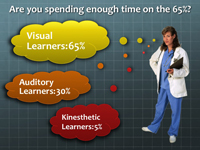From Presentation To Practice – Laser Pointer’s Tips For Healthcare Presentations That Facilitate Physician Practice Improvement

It’s November and invitations are going out to speakers for next year’s medical and dental conferences. Typically, the speaker is provided with a topic and given deadlines for their title and synopsis. The actual slide presentation is often not assembled until days or even hours before hitting the podium. Are these lectures improving clinical practice as intended?
Laser Pointer President Margy Schaller has seen hundreds of such presentations and listened to the audience during breaks make comments such as “interesting speaker, but I don’t ever see those type of cases”, or “we tried that and it didn’t work”, or worst of all, “what a waste of time, we thought this was going to be more advanced.”
The purpose of clinical lectures is to share information that will facilitate physician practice improvement, and ultimately provide optimal care to patients. Great effort goes into research projects, the development of new protocols and/or the questioning of currently accepted practices. Is the same effort going into the transmission of this knowledge?
Recently, the AMA announced their $11 million grant project to “Accelerate Change In Medical Education” focusing on the development of new modalities in medical schools. http://www.ama-assn.org/sub/accelerating-change/overview.shtml. A consistent element in the awarded grants is the inclusion of self-directed and patient-centered education, a nod towards adult learning preferences.
Today’s continuing education activities must also evolve, getting away from dry bullet lists of data and into patient-centric storytelling as the means for translatable teaching. Further, medicine’s own studies on visual learning preferences should be applied to their own slide decks by removing text and adding pictures.
Laser Pointer recommends following these steps to deliver a compelling lecture and facilitate clinical improvement:
1. Request a needs assessment.
Depending on the type of conference, this may include comments from the prior year’s evaluations, a survey of the membership, or simply a conversation with the organizer to understand what the audience is looking for.
2. Provide an accurate lecture title and synopsis.
Resist the temptation to keep this broad enough for wiggle room. Ensure to include target audience, level of difficulty, procedures or protocols to be covered along with the learning objectives.
3. Consider hiring a medical presentation designer.
Once the presentation is in it’s rough form, let a professional optimize the slide deck to ensure that what is shown is as powerful as what will be said. After all, over 65% of the population learns best visually.
4. Get the audience involved in their own learning.
Utilize interactive presentation methods such as an audience response system to take the pulse of the group. Set up a “point vs. counter-point” debate on different methodologies for the same case. Open for questions every 15 minutes rather than only at the end.
5. Request a copy of the post course evaluation and revise accordingly.
Most medical and dental presentations are given multiple times, or adapted for multiple uses. Tell the audience in advance that you are planning to use their feedback for future revisions, and then be open to their comments.
By following these recommendations and including patient case stories throughout a presentation, the audience is more likely to go home saying, “I think I’m going to try that new procedure on my next patient.”
Laser Pointer’s captivating, yet professional style has improved countless medical presentations by always having an eye on the ultimate goal, improving patient care.
